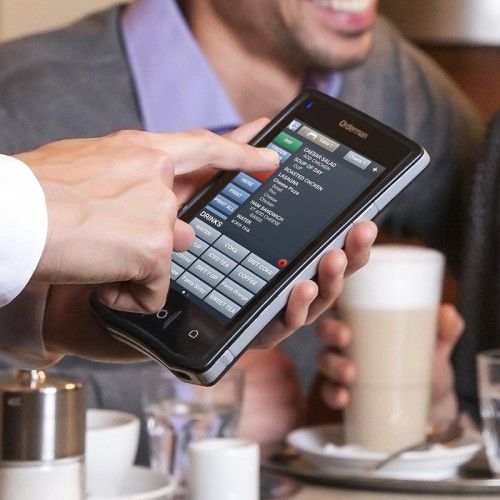
9.23.2021
As Vice President of Marketing for NCR Hospitality, Jessica Bryant leads marketing direction for NCR’s digital-first restaurant technology portfolio, including building a deep understanding of customers’ changing needs and requirements. She has served in several leadership roles including head of hospitality and retail marketing and has been with NCR since its acquisition of Radiant Systems in 2011. Prior to joining Radiant Systems, Jessica held marketing management positions at Recall, Inc. and the Metro Atlanta Chamber of Commerce.
What are the biggest challenges restaurants are facing now, and how does NCR technology plan to adjust to these new needs?
The past year has created both challenges and opportunities. Brands are looking at new service models and restaurant formats – like creating virtual brands, curbside pickup and drive-thru transformation – to drive operational efficiencies and protect profit margins. For brands that are reimagining their restaurant formats, NCR provides strategic advisory services and a range of technology solutions to help operators quickly pivot from the physical to the digital. An example is a digital make line we created in the kitchen of a well-known fast casual brand that has helped staff build menu items faster, with more than 99% accuracy, and reduce wait time for pickup of mobile orders.
reimagining their restaurant formats, NCR provides strategic advisory services and a range of technology solutions to help operators quickly pivot from the physical to the digital. An example is a digital make line we created in the kitchen of a well-known fast casual brand that has helped staff build menu items faster, with more than 99% accuracy, and reduce wait time for pickup of mobile orders.
Restaurants are also having challenges recruiting, training and retaining talent. The challenges we are seeing with employee hiring and retention can be offset by technology that helps restaurants cover more tables with less staff, while still providing a delightful guest experience. NCR technology can help operators transform their service models in two ways. The first is introducing handheld POS that enables staff to take orders and payments at the table and send orders directly to the kitchen. The second is enabling QR codes placed at the table for the guest to control their entire dine-in experience with their own device.
And we’re in the middle of a complete transformation of how brands engage their guests, including the introduction of new digital and physical experiences and the guest expectation of personalization. It’s no longer enough just to have a basic loyalty program. NCR’s consumer marketing capabilities enable restaurant brands to identify, understand and engage their most valuable customers to go beyond transactional loyalty to true loyalty.

Many restaurants are extending their reach to grocery aisles, what benefits do you see from this new business model?
This increasingly popular business model of offering packaged foods in stores enables restaurants, most of which operate within slim margins, to create additional revenue streams and get their brand in front of more customers. Brands like Starbucks and Krispy Kreme have been doing this for years and other brands see the benefits of bringing their items to store shelves.
During the pandemic, particularly when dining rooms closed, consumers became accustomed to cooking their own meals. In doing so, they turned to stores, whether online or brick-and-mortar locations, for their favorite food and drink items. And many brands took notice, making sure their signature sauces, breads, drinks and so on were available for purchase.
Introducing restaurant-branded products in stores is a brilliant way for restaurants to get new customers to try their products or remind people how much they enjoyed a particular item that they used to enjoy in the restaurant. This is a growing trend that we’ll see continue.
NCR recently announced a major acquisition of LibertyX, what do cryptocurrency and blockchain mean for the restaurant industry?
Consumers increasingly desire digital currency solutions and want companies they conduct business with to accept digital currency payments across digital and physical channels. Restaurants included. Therefore, many restaurants are beginning to require an all-in-one digital currency solution. And NCR wants to arm our restaurant customers with the ability to allow their diners to transact in any form they choose – from cash to credit card to digital wallet to cryptocurrency. Offering diners a more flexible payment experience will enable brands to keep up with the times and reach more digitally savvy generations, particularly Millennials and Generation Z guests.

NCR also announced it is supporting restaurant recovery by donating to Elevate Together, can you tell us more about this partnership and how it aids restaurant operators?
The restaurant industry has undergone an incredibly challenging year and a half, and NCR wants to assist in supporting restaurant recovery, particularly in minority communities. The company is donating $200,000 to Elevate Together™, a nonprofit initiative designed to create growth and prosperity for Black and Hispanic communities. The donation, awarded by the NCR Foundation – a founding partner of Elevate America – will be used to award cash grants to Atlanta-area minority-owned businesses.
Elevate Together is powered by Round It Up America® (RIUA), a nonprofit organization that invites restaurant guests and retail locations to round up their checks, using the NCR Aloha POS platform, to the nearest dollar and donate the remaining change to a restaurant’s charity of choice.
What can restaurants learn from the past year?
Adaptability and consistency were key and continue to be so crucial in this industry. Unexpected events happen, and restaurants learned they must shift operations, even for long periods. Those that didn’t pivot quickly suffered.
Restaurants that provided robust takeout and delivery options and allowed diners to order and pay for their food with touchless solutions, for instance, fared much better than those who couldn’t pivot as quickly. Technology is key to enabling change, to keeping the restaurant running, and to giving customers what they want – and how they want it. And brands that already had a strong digital presence or could quickly improve their online or multichannel presence were the ones to make it on the other side of a pandemic.
Moving forward, restaurants should consider investing in technology that enables a restaurant to integrate all systems and applications into one robust, intuitive platform. Doing so will help them handle blips in the road and ongoing changes in the industry. They should also strive to find a technology provider that can help acquire, deploy, monitor and manage all the technology needed to run the restaurant. This can help free up IT staff and key personnel to focus on strategic growth initiatives versus managing the growing technology footprint inside and outside the restaurant.

